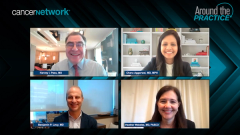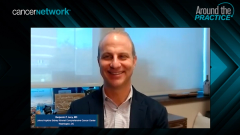
Role of Immunotherapy in Newly Diagnosed NSCLC
A broad discussion on the role of immunotherapy in newly diagnosed NSCLC in both the neoadjuvant and adjuvant settings.
Episodes in this series

Transcript:
Charu Aggarwal, MD, MPH: This recording is occurring before the CHECKMATE-816 presentation at AACR [American Association for Cancer Research]. I would ask each one of you if you were seeing this patient today, what would you recommend? Would you recommend neoadjuvant treatment followed by surgery or would you recommend surgery followed by further evaluation, remembering that this patient has had biomarker testing, is negative for at least the four major actionable mutations and the PDL1 level is high? I guess I’ll start with you Harvey, what’s your inclination at this time without really seeing the DFS [disease-free survival] data?
Harvey I. Pass, MD: Frankly, with all of the data with the phase 2s and now with a phase 3 trial that actually shows there is a benefit for induction, I would advocate strongly that this patient would get induction chemo. It could be induction chemo or radiation. I’m sorry, induction immuno-chemo or induction-immuno alone. I don’t know which is better at this point, but certainly, it seems to me that induction immuno-chemo is a standard that is going to be rapidly adopted, and so I would be pushing for that. I think it could be done safely, as we’ve all learned from 816 and other trials. Then the question of how you’re going to treat the patient afterward with maintenance immunotherapy is another one to discuss, but I would strongly advocate for this patient to get induction therapy.
Charu Aggarwal, MD, MPH: That’s interesting because I think as a surgeon, the initial instinct is to go in and treat or go in and resect as quickly as you can, but it’s really refreshing to hear that you would rather have this patient receive some kind of induction treatment.
Harvey I. Pass, MD: It’s the medical oncology gene that always has been with me since NCI [National Cancer Institute]. I don’t know what it is, but also it’s just the right thing to do. We know for a fact that patients like this will recur, and T3N0 has a median survival of about 50%. You don’t really want to have to worry about this when you’ve got data now. Just say that you can do it safely and efficaciously.
Charu Aggarwal, MD, MPH: Heather, I’ll ask you as the lead investigator for IMpower010, do you disagree and favor adjuvant approaches of this setting? How would you treat this patient today?
Heather Wakelee, MD, FASCO: This is definitely a case we would talk about now in our tumor board, now that we do have the neoadjuvant approval for NIVO added to chemotherapy. We would talk through that. There are definitely pros and cons, and I don’t think we fully know the answer. The data we have so far, we have one randomized phase 3 neoadjuvant study, which Harvey was just talking about and we’ll talk about more soon, which showed a definite benefit over neoadjuvant chemo. Now we have 2 positive adjuvant trials with IO after chemo. Most of the neoadjuvant trials, of course, give neoadjuvant and then they give adjuvant, and we haven’t seen those results yet. But obviously, that’s kind of tempting now that we have positive on the two pieces separately, putting it together makes some sense. I haven’t had to face this exactly, so it’s always hard when you’re like, what would you actually do? We would certainly talk with the patient. A lot of patients have strong feelings about whether they would just like to go through their surgery first. We do have to acknowledge that with neoadjuvant trials, somewhere between 10% to 15% of patients enrolled don’t go to surgery, whether that’s because they really weren’t ever destined for surgery or it’s something about that neoadjuvant. It’s a risk that we have to be mindful of. That’s why it would be important to have a discussion with all the details about the patient and then kind of bring the patient into that decision-making.
Charu Aggarwal, MD, MPH: Ben, you’ll be our tiebreaker, not quite a tiebreaker because we’re all sort of saying the same thing, but I’m interested in what you would say.
Benjamin P. Levy, MD: I don’t know if there’s a right answer. I can tell you that having treated several patients, both on study, we had 816 tier, and off study with neoadjuvant chemo-IO, I’ve become a little bit of a believer in what we’ve seen, at least at the level of the tissue analysis at the time of surgical resection. I think Heather makes a good point, and this is where medicine becomes an art and not a science. I think this is shared decision-making with the patient. That’s a tough one because sometimes patients don’t want to participate and they say, you make the call. I would say, if that comes up, I would encourage a chemo-IO approach. Although, again, as Heather mentioned, there are competing strategies here. We do have other data, obviously in the neoadjuvant chemo-IO realm with other trials that look just as promising, and now we have this phase 3 trial. The one thing again, I’d say, is this is again a call for multidisciplinary care. I will tell you that my surgeon and I talk about these cases all the time, and we see them in the clinic together and it helps, but gosh, the world’s gotten a little complicated here in the early-stage setting. I will put my nickel down and be the tie-breaker here. I would vote for chemo-IO. You’ve got the markers. You know the patient doesn’t have an EGFR-ALK. There are a lot of theoretical advantages to using neoadjuvant chemo versus adjuvant independent of the data we’ve seen, so I would opt for chemo-IO, but I’ll hedge and say that it’s shared decision-making as well.
Charu Aggarwal, MD, MPH: Clearly, there are several treatment approaches here. We could go with upfront surgery, followed by chemo, followed by adjuvant immunotherapy. We could do neoadjuvant chemo-IO, followed by a discussion of we don’t really know what to do. Do we need to give additional treatment or not? Let’s see what happened with this case. The patient and the treating physician opted to proceed with surgery. The patient underwent a left lower lobectomy, and a tumor was found in a station 10 lymph node that was subsequently resected. Finally, the path staging revealed a T3N1M0 non-small cell lung cancer stage 3A. She went on to receive four cycles of cisplatin and pemetrexed followed by atezolizumab in the adjuvant setting. Does this change the overall treatment and prognosis? This up-staging with this N1 disease? Do you view this differently or this is sort of par for the course and expected with a 5 and a half-centimeter tumor? Harvey, you were alluding to this earlier. Any thoughts on this?
Harvey I. Pass, MD: Yeah. Level 10 is a difficult one unless you’re going to do a mean really. For me, it’s not surprising that it’s a large tumor. You certainly could have micrometastases that are picked up at the time of surgery. This depends upon how efficient you are at doing your lymph node dissection. Remember level 10 is sort of outside and inside the lung, so you got to dissect those. It’s up to the surgeon to get those nodes so that you really know what the stage is. For me, this is not a good actor. This is T3N1. These have even worse 5-year survivals, of course, in the T3N0s. They can be around 40%, so this patient is going to need to have some more therapy and is going to need to be referred. You’re going to have to look at the final pathology. You have the immunos, but this is a bad actor and it’s an adeno and this is one that our medical oncologist would certainly do further NGS on. They would also treat and give options for treatment. Those can certainly be discussed with the patient, but with Heather’s study, certainly which I’m sure she’ll expand on, this is a wonderful option at this point for a patient like this.
Transcript edited for clarity.
Newsletter
Stay up to date on recent advances in the multidisciplinary approach to cancer.


























































































